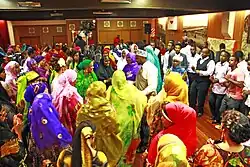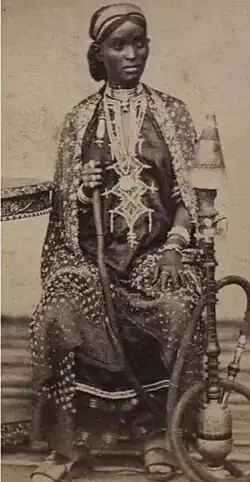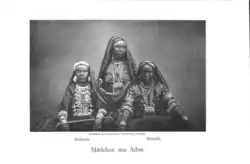Dirac (dress)
 Somali women wearing dirac at a wedding | |
| Type | Somali dress style |
|---|---|
| Place of origin | Somalia |


The dirac (see Baati for the house dress) is a Somali[1][2][3][4][5][6][7] garment worn by Somali women that is long, usually ankle length. The dirac was designed for the harsh hot weather of Somalia, hence its name, which comes from the Somali term that means "protector" or "protection".
Types
The dirac is most commonly worn during celebrations/special events such as weddings, parties, festivals etc. Fancier sets of dirac are sought after for weddings. It is usually made out of either chiffon, silk (which are both usually the sheerest variation of a dirac) or velvet (one of the least see-through), amongst many other materials. It is always accompanied with an ankle length underskirt called gorgorad/googarad and a wrap/shawl called garbasaar, which is either worn loosely around the head or neatly on one shoulder.[5][7][8][9][10][11][12]
The baati/dirac shiid is yet another variation traditionally worn as a house dress and is made of cotton. This version is very popular within the entirety of East Africa due to Somali trading within those countries and is seen as a staple clothing.[10][7]
This visual style appears in a late 19th-century photograph attributed to Wilhelm Joest, showing a seated woman wearing a sheer, embroidered dirʿ and traditional jewelry.[13]
History
The dirac originated from Northern Somalia, when it was created by a group of Somali women, but was popularised in the early/mid 1900s in Somalia and Djibouti. It then gradually spread to the rest of the Somali regions. It was made with colourful fabric, mainly locally made but some imported.[3][14][15][16][17]
References
- ^ Allman, Jean Marie, ed. (2004). Fashioning Africa: power and the politics of dress. African expressive cultures. Bloomington, Ind: Indiana University Press. ISBN 978-0-253-11104-3.
- ^ Kiiru, Kahithe; wa Mũtonya, Maina, eds. (2018). Music and Dance in Eastern Africa: Current Research in Humanities and Social Sciences. Africae Studies. Nairobi: Africae. ISBN 978-9966-028-75-4.
- ^ a b Liberatore, Giulia (2017). Somali, Muslim, British: striving in securitized Britain. London School of Economics monographs on social anthropology. London New York, NY: Bloomsbury Academic. pp. 133, 280. ISBN 978-1-350-02771-8.
Although the dirac originates from the northern Somali territories, it only became fashionable among Somalis in the 1960s (Akou 2011) and among Somalis in the diaspora it has come to symbolize traditional Somali cultural dress. It is typically worn at weddings and other Somali events.
- ^ Bassel, Leah (2012). Refugee women: beyond gender versus culture. Routledge advances in sociology. New York: Routledge. p. 178. ISBN 978-1-136-85055-4.
- ^ a b Taylor, Ken; Williams, Victoria, eds. (2017). Etiquette and taboos around the world: a geographic encyclopedia of social and cultural customs. Santa Barbara, California: Greenwood, An Imprint of ABC-CLIO, LLC. p. 121. ISBN 978-1-4408-3821-7.
- ^ Jafar, Afshan, ed. (2013). Global beauty, local bodies. New York, NY: Palgrave Macmillan. pp. 104, 106. ISBN 978-1-137-36534-7.
- ^ a b c Yan, Xinfeng; Chen, Lihong; Memon, Hafeezullah, eds. (2023). Quality education and international partnership for textile and fashion: hidden potentials of East Africa. SDGs and textiles. Singapore: Springer. pp. 19–20. ISBN 978-981-99-1320-6.
- ^ Akou, Heather Marie (2011). The politics of dress in Somali culture. African expressive cultures. Bloomington: Indiana University Press. p. 82. ISBN 978-0-253-35629-1.
- ^ Osman Omar, Abla (1998). Somalia. Storia Economia e Risorse, Società e Tradizioni, Arte e Cultura, Religioni. Edizioni Pendragon. p. 68.
- ^ a b M. Lowell, Lauren (2024). Dressing Historical Characters Clothing History for Entertainment Designers. Waveland Press. p. 235.
- ^ Akou, Heather Marie (2011). The politics of dress in Somali culture. African expressive cultures. Bloomington: Indiana University Press. pp. 104, 108. ISBN 978-0-253-35629-1.
- ^ Guerin, Pauline; Hussein Elmi, Fatuma; Guerin, Bernard (2006-01-01). "Weddings and parties: Cultural healing in one community of Somali women". Australian e-Journal for the Advancement of Mental Health. 5 (2): 105–112. doi:10.5172/jamh.5.2.105. ISSN 1446-7984.
- ^ Joest, Wilhelm (1885). Um Afrika. M. Dumont-Schauberg. p. 287.
- ^ Eicher, Joanne Bubolz; Ross, Doran H. (2010). Berg encyclopedia of world dress and fashion. New York: Berg. pp. 413–420. ISBN 978-1-84788-390-2.
Dirac – a knee- or ankle-length, thin, loose dress worn in agricultural and nomadic areas; a fashion that came from northern Somali territory in the 1960s
- ^ Behnke, A. (2016). The International Politics of Fashion: Being Fab in a Dangerous World. Popular Culture and World Politics. Taylor & Francis. p. 220. ISBN 978-1-317-65622-7. Retrieved July 19, 2021.
- ^ Akou, Heather (9 September 2004). Fashioning Africa: Power and the Politics of Dress. Indiana University Press. pp. 50–63. ISBN 978-0-253-11104-3.
- ^ Lulling, Virginia (2001). A Somali sultanate: the Geledi city-state over 150 years. London: HAAN. p. 68. ISBN 978-1-874209-98-0.